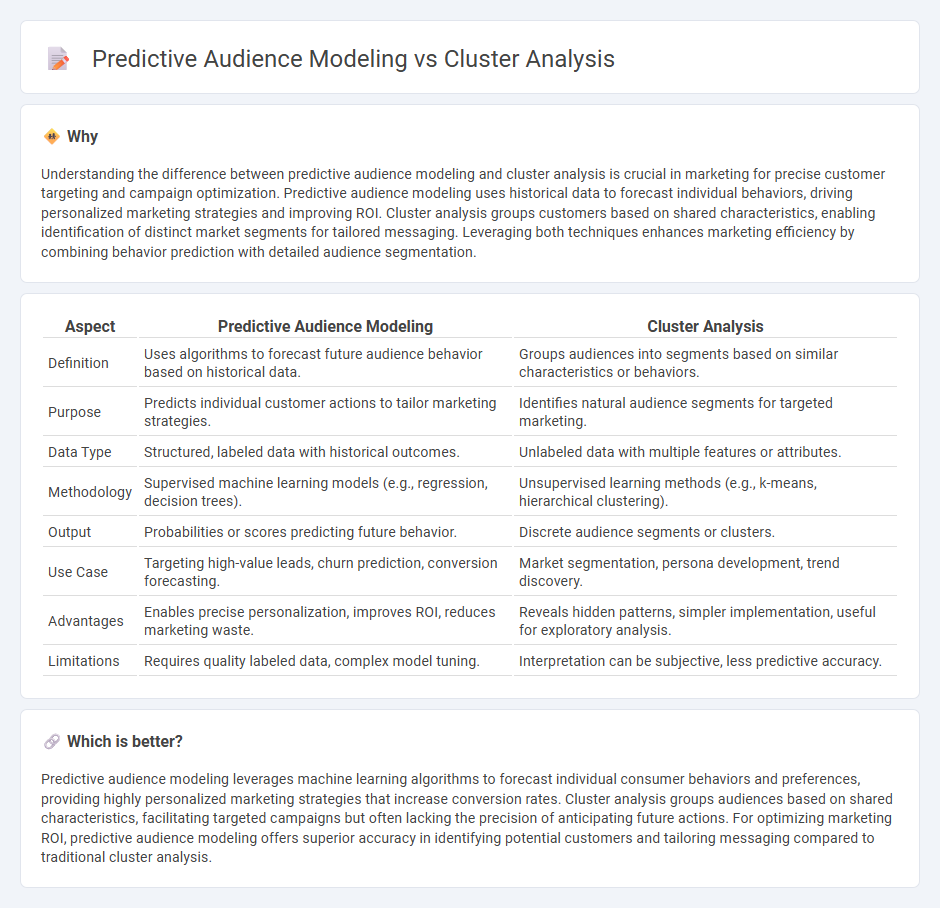
Predictive audience modeling uses machine learning algorithms to forecast individual consumer behaviors based on historical data, enabling personalized marketing strategies. Cluster analysis segments audiences into distinct groups by identifying patterns and similarities within datasets, allowing targeted messaging to broad market segments. Explore these powerful techniques to enhance your marketing precision and drive higher engagement.
Why it is important
Understanding the difference between predictive audience modeling and cluster analysis is crucial in marketing for precise customer targeting and campaign optimization. Predictive audience modeling uses historical data to forecast individual behaviors, driving personalized marketing strategies and improving ROI. Cluster analysis groups customers based on shared characteristics, enabling identification of distinct market segments for tailored messaging. Leveraging both techniques enhances marketing efficiency by combining behavior prediction with detailed audience segmentation.
Comparison Table
| Aspect | Predictive Audience Modeling | Cluster Analysis |
|---|---|---|
| Definition | Uses algorithms to forecast future audience behavior based on historical data. | Groups audiences into segments based on similar characteristics or behaviors. |
| Purpose | Predicts individual customer actions to tailor marketing strategies. | Identifies natural audience segments for targeted marketing. |
| Data Type | Structured, labeled data with historical outcomes. | Unlabeled data with multiple features or attributes. |
| Methodology | Supervised machine learning models (e.g., regression, decision trees). | Unsupervised learning methods (e.g., k-means, hierarchical clustering). |
| Output | Probabilities or scores predicting future behavior. | Discrete audience segments or clusters. |
| Use Case | Targeting high-value leads, churn prediction, conversion forecasting. | Market segmentation, persona development, trend discovery. |
| Advantages | Enables precise personalization, improves ROI, reduces marketing waste. | Reveals hidden patterns, simpler implementation, useful for exploratory analysis. |
| Limitations | Requires quality labeled data, complex model tuning. | Interpretation can be subjective, less predictive accuracy. |
Which is better?
Predictive audience modeling leverages machine learning algorithms to forecast individual consumer behaviors and preferences, providing highly personalized marketing strategies that increase conversion rates. Cluster analysis groups audiences based on shared characteristics, facilitating targeted campaigns but often lacking the precision of anticipating future actions. For optimizing marketing ROI, predictive audience modeling offers superior accuracy in identifying potential customers and tailoring messaging compared to traditional cluster analysis.
Connection
Predictive audience modeling leverages cluster analysis to segment consumers based on shared behaviors and attributes, enabling more accurate forecasting of future actions. Cluster analysis groups data points into meaningful clusters, providing the foundation for identifying high-value customer segments in predictive models. This synergy enhances targeted marketing strategies by anticipating audience needs and optimizing campaign performance.
Key Terms
Cluster Analysis:
Cluster analysis segments audiences based on shared characteristics, uncovering natural groupings within data without prior assumptions. This method enables marketers to understand distinct audience profiles by grouping individuals with similar behaviors, preferences, and demographics, enhancing targeted marketing strategies. Explore more to discover how cluster analysis can optimize your audience segmentation for improved campaign effectiveness.
Segmentation
Cluster analysis groups audiences based on shared attributes to identify distinct segments, enhancing targeted marketing strategies. Predictive audience modeling uses historical data and algorithms to forecast future behaviors and preferences within these segments. Explore how integrating both techniques can optimize your audience segmentation and campaign effectiveness.
Similarity Measures
Cluster analysis groups data points by calculating similarity measures such as Euclidean distance, cosine similarity, or Manhattan distance to identify natural groupings without predefined labels. Predictive audience modeling leverages similarity metrics as features within supervised learning algorithms to forecast user behavior or preferences based on historical data patterns. Explore the nuances of similarity measures in these methodologies to optimize segmentation and prediction strategies effectively.
Source and External Links
What is cluster analysis in marketing? - Adobe Experience Cloud - Cluster analysis is a statistical method that identifies and groups similar data points while highlighting differences, aiming for useful, consistent, and actionable groupings for tasks such as marketing segmentation.
Conduct and Interpret a Cluster Analysis - Statistics Solutions - Cluster analysis is an exploratory technique for finding natural groupings in data, using methods like K-means, hierarchical, and two-step clustering to reveal meaningful clusters that support decision-making across domains.
Cluster Analysis - Methods, Applications, and Algorithms - Spotfire - Cluster analysis categorizes data into naturally occurring groups using various algorithms such as partition-based (K-means), hierarchical, density-based, and model-based methods to optimize cluster quality and applicability.
 dowidth.com
dowidth.com